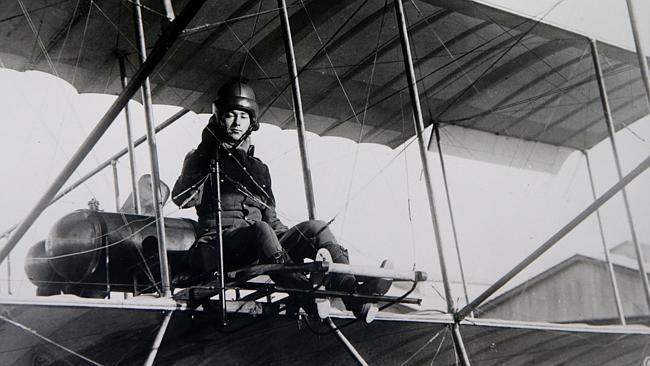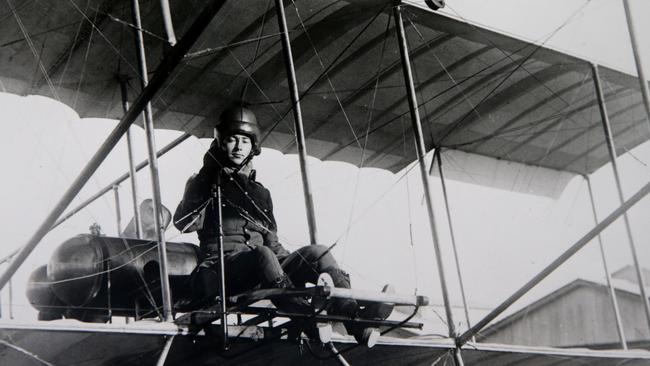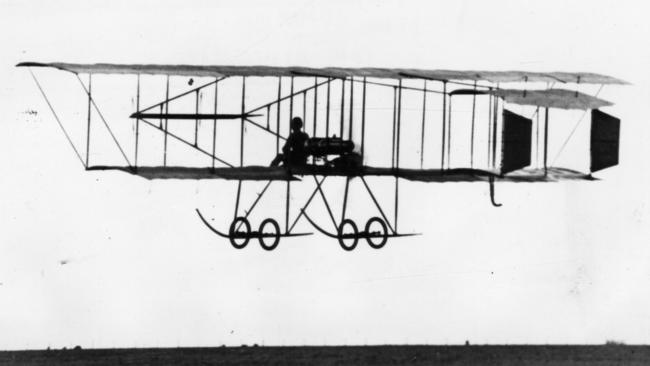Tragic young doctor George Merz became Australia’s first fighter pilot hero
NEWLY-QUALIFIED doctor George Merz was still helping out in a World War I field hospital just hours before he took off on his final mission as a pioneer fighter pilot.

Today in History
Don't miss out on the headlines from Today in History. Followed categories will be added to My News.
UNAWARE of the fate awaiting him, newly qualified doctor George Merz spent the evening of July 29, 1915, helping out in understaffed Nasiriyeh hospital in Mesopotamia, treating Allied soldiers critically wounded in Turkish bombardments.
Next day the pioneering Australian air force officer joined New Zealand officer Lieutenant William Burn to fly 210km from Nasiriyeh south to Basra, on the Euphrates River. Forced to land by mechanical failure during a dust storm, the aviators were never seen again. Merz, a talented pilot, became the first Australian airman to perish in World War I.
Born at Prahran on October 10, 1891, the only son of George and Annie Merz, in the mid-1890s the family moved to Ballarat. Merz was dux of his school and won a £200 scholarship to study at the University of Melbourne, where he enrolled in medicine.

Commissioned as a 2nd Lieutenant in the Melbourne University Rifles, World War I began as Merz prepared for his final exams. At the same time the first Australian military flying school opened in a sheep paddock at Point Cook, near Werribee on Melbourne’s outskirts.
REACH FOR THE SKIES
Federal defence minister Senator George Pearce had proposed an Australian Aviation Corps in January 1911, and recruited British lieutenants Henry Petre and Australian-born Eric Harrison as Australia’s first flying instructors.
OUR FIRST WORLD WAR I HEROES FINALLY HONOURED
QANTAS TREATS WAR HERO AND FORMER PILOT TO SPECIAL TOUR
Petre arrived in Australia in January 1913 to select a site for the flying school he would command. After travelling hundreds of kilometres by motorcycle, Petre rejected the government’s preferred location at Canberra, near the Royal Military College, Duntroon. Instead he selected 297ha of flat terrain with land and sea access at Point Cook, purchased for £6040.
Harrison sailed with five aircraft — two BE2A, two Deperdussin, and one Bristol — by the end of 1913. Petre and Harrison, with four mechanics, a clerk and a caretaker, opened the school in February 1914, equipped with corrugated iron and canvas hangars, and tents for officer accommodation.

The first flying course began on August 17, 1914. Merz was one of its first four students, along with Lieutenant (later Air Marshal) Richard Williams, Captain Thomas White and Lieutenant David Manwell.
Merz’s father explained his son “asked me to let him take up flying for three months as he had five years of hard study for medicine. The wife and I allowed him to go”.
THE STAR STUDENT
Merz was first in the air, rising to 30m in a Bristol Boxkite with Harrison at the controls, on the morning of August 18. With more than 10 hours flying time, half of it solo, and training in navigation and engineering, Merz was a star student, earning a distinction in every subject.
On graduating, he shipped to New Guinea with Harrison in November to support the Australian Naval and Military Expeditionary Force. Merz suffered malaria and reached Rabaul in December as German occupiers withdrew.
With their planes not removed from shipping crates, in January 1915 Merz and Harrison returned to Point Cook.
Although planning to head to war as a regimental medical officer, Merz was recruited as an aviation trainer at Point Cook. Arguing that he was primarily a doctor, with flying as a hobby, Merz’s schedule allowed him to work two shifts a week at Melbourne Hospital.
MISSION TO FLY
As Merz took up his first students in March, the federal government was considering an Indian government request for airmen and aircraft for aerial reconnaissance in Mesopotamia.
Petre sailed for Bombay on April 20, 1915, to form the First Half Flight comprising four pilots, mechanics and a total staff of 45. Merz, by then engaged to nurse Dora Rowe, left Melbourne on May 12, 1915, to join Petre on June 13.
In a letter to his family, Indian doctor Kalyan Mukherji, based at Nasariyeh hospital, described the aftermath of a battle waged against Turks on July 23, 1915.
“At about three a band of enemy prisoners and wounded arrived,” he wrote. “From six-thirty in the morning till 1pm I didn’t have a chance to breathe. A river of blood, red — all around — I myself, soaked in blood, to the skin.”
FINAL FLIGHT INTO THE UNKNOWN
George Merz, with William Burn as his passenger, flew out of Nasariyeh between 5am and 6am on July 30. Royal Flying Corps pilot Major Hugh Reilly left within an hour. Engine trouble also forced Reilly to land. Helped by Arab tribesmen, he continued to Basra. When Merz had not arrived by August 2, Henry Petre joined Reilly in a search that found his badly damaged aircraft.
Merz’s family was advised on August 12, 1915, that the engine of his Cauldron aircraft had failed over the desert near the river: “The aeroplane was found in a damaged condition by the Arabs, but no sign of the officers. It is reported they were taken prisoners, but this is unconfirmed.”
After questioning Arab tribesmen, a Court of Inquiry concluded Bedouin Beni Malik tribesmen attacked the airmen, who fought them off with pistols until one was injured. The other remained with him. Both were killed and neither of their bodies was recovered.
Originally published as Tragic young doctor George Merz became Australia’s first fighter pilot hero


